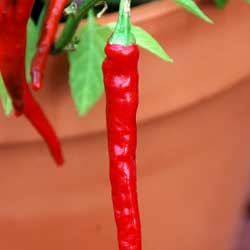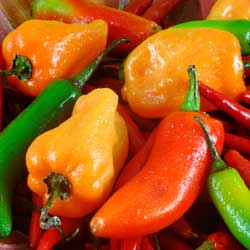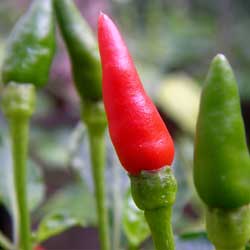How hot do your peppers grow? Have you ever wanted to describe how hot your peppers are, but just didn’t know how? Have you ever noticed the variety of pepper seeds available, and wondered how hot the peppers will be? The “Scoville Scale” helps. Designed by Wilbur Scoville in 1912, it quantifies the amount of capsaicin, the chemical producing the “fire” in a pepper. This allows comparison.
Here’s a listing of popular peppers by their “heat:”
| Scoville Heat Units |
Pepper Varieties |
| Negligible |
Bell pepper, Aji dulce |
| 100-900 |
Pimento, Pepperoncini, Banana pepper, Cubanelle, Felicity Jalapeno |
| 1,000-2,500 |
Anaheim pepper (cultivar of New Mexican peppers) Poblano pepper, Rocotillo pepper, Peppadew, Sriracha sauce,Gochujang |
| 3,500-8,000 |
Espelette pepper, Jalapeño pepper, Chipotle, Smoked Jalapeño, Guajillo pepper, New Mexican peppers, Hungarian wax pepper, Tabasco sauce |
| 2,500-10,000 |
Fresno pepper |
| 10,000-23,000 |
Serrano pepper, Peter pepper, Aleppo pepper |
| 30,000-50,000 |
Guntur chili, Cayenne pepper, Ají pepper, Tabasco pepper, Cumari pepper (Capsicum Chinese) |
| 50,000-100,000 |
Byadgi chili, Malagueta pepper, Chiltepin pepper, Piri piri (African bird’s eye chili), Pequin pepper, Siling Labuyo (native chili cultivar from the Philippines) |
| 100,000-350,000 |
Habanero chili, Scotch bonnet pepper, Datil pepper, Rocoto, Piri Piri Ndungu, Madame Jeanette, Peruvian White Habanero, Jamaican hot pepper, Guyana Wiri Wiri, Fatalii |
| 350,000-580,000 |
Red Savina habanero, Caribbean Red |
| 855,000-1,463,700 |
Naga Viper pepper, Chili, Bhut Jolokia chili pepper (Ghost pepper), Trinidad Scorpion Butch T pepper, Bedfordshire Super Naga, 7-Pot Chili (Yellow Lantern Chili) |
| 1,500,000-2,000,000 |
Trinidad Moruga Scorpion, Carolina Reaper |
Now that you’ve decided what peppers you want to grow, here’s the scoop of how to grow them:
Outdoors
Prior to transplanting self-grown or purchased seedlings, prepare the growing bed. Peppers grow best in full sun in rich and well-drained warm soil. Add compost and a light dressing of 5-10-10 fertilizer. Overfertilizing causes leaf growth but not pepper growth. By the way, the “days to maturity” on the seed package is an approximate number of days until the fruit is ready for harvest, counting from the date of transplanting outdoors.
Water regularly and deeply but don’t allow the soil to become waterlogged. Weed to reduce nutrient competition and watch for pests.
That’s all there is to it!




